October 27, 2023
Air Date: October 27, 2023
FULL SHOW
SEGMENTS
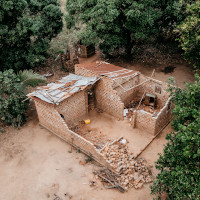
Rift Over Loss and Damage
View the page for this story
Wealthy nations have agreed to pay low-income countries for some of the loss and damage caused by the climate crisis. But rich and poor nations are still divided on key elements of the fund with just a few weeks to go before COP 28. Bob Berwyn, a journalist with Inside Climate News, joins Host Jenni Doering to explain. (10:17)

Greening Maine's Grid?
/ Annie RopeikView the page for this story
On November 7th voters in the state of Maine will be able to choose if they want to replace the state’s two existing for-profit electric utilities with a non-profit utility largely governed by an elected board. Freelance reporter Annie Ropeik discusses with Host Steve Curwood how the new utility could help the state decarbonize its electricity sector. (07:32)
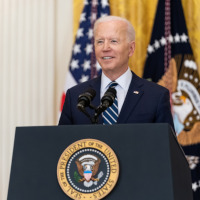
Advancing Hydrogen with Government Funded Hubs
View the page for this story
The Biden Administration recently announced the recipients of up to $7 billion in grants for seven hydrogen technology “hubs” across the country to help move away from fossil fuels. Inside Climate News reporter Nicholas Kusnetz explains to Host Jenni Doering why any climate benefits depend on the sources of hydrogen. (11:43)
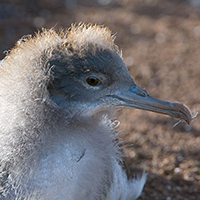
BirdNote®: Spooky Shearwaters
/ Michael SteinView the page for this story
At Halloween, we think of ghoulies and ghosties and long-leggitty beasties – indeed, you may even get some of them at your door demanding candy. And as Michael Stein tells us in today’s BirdNote®, some of our avian acquaintances would fit right in. (02:05)
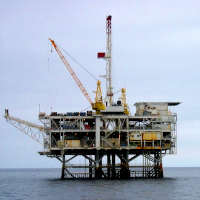
Beyond the Headlines
/ Peter DykstraView the page for this story
This week, Living on Earth contributor Peter Dykstra joins Host Steve Curwood to divulge how decommissioned offshore oil rigs can become homes for sea life in what are dubbed “rigs to reefs.” Also, churches are putting solar panels on their roofs to engage in “creation care.” And in history they look back to the opening of the first New York City subway line, all the way back in 1904. (04:22)

Sacred Groves in China
View the page for this story
In the Yunnan Province in Southwest China, generations of locals have protected sacred forest groves that some consider the homes of the spirits of their ancestors. Lily Zeng researched these “holy hills” as part of her doctoral studies at Yale School of the Environment and she joined Living on Earth’s Bobby Bascomb to describe them. (07:44)
Show Credits and Funders
Show Transcript
231027 Transcript
HOSTS: Steve Curwood, Jenni Doering
GUESTS: Bob Berwyn, Nicholas Kusnet, Annie Ropeik
REPORTERS: Peter Dykstra, Michael Stein
[THEME]
CURWOOD: From PRX – this is Living On Earth.
[THEME]
CURWOOD: I’m Steve Curwood.
And I’m Jenni Doering.
In advance of the COP28 climate summit this December, wealthy and low-income countries are still at odds over loss and damage.
BERWYN: There are some countries that are feeling the impacts of greenhouse gas emissions, but don't actually emit very many greenhouse gases themselves. You're not going to have a lasting sustainable climate solution until these things are addressed.
CURWOOD: Also, voters in Maine will consider replacing for-profit utilities with a nonprofit company.
ROPEIK: The new utility would have this explicit purpose to help the state meet its climate goals, and Maine has pretty aggressive climate goals. We want to be 80% renewable by 2030; a number of other goals. And so the new utility would be required to help with those efforts.
CURWOOD: This week on Living on Earth – Stick Around!
[NEWSBREAK MUSIC: Boards Of Canada “Zoetrope” from “In A Beautiful Place Out In The Country” (Warp Records 2000)]
[THEME]
Rift Over Loss and Damage

Tropical Cyclone Freddy, one of many natural disasters likely influenced by climate change, hit the developing country of Mozambique in the spring of 2022 and destroyed many homes. (Photo: Mbuto Machili, Global Partnership for Education, Flickr, CC BY-NC-ND 2.0)
CURWOOD: From PRX and the Jennifer and Ted Stanley Studios at the University of Massachusetts Boston, this is Living on Earth. I’m Steve Curwood.
DOERING: And I’m Jenni Doering.
Wealthy nations agreed at the annual UN climate conference last year, COP 27, to pay low-income countries for some of the loss and damage caused by the climate crisis. It’s a huge toll and growing. According to a May 2023 report from the World Meteorological Organization, extreme weather and climate-related events over the last 50 years caused a whopping 4.3 trillion dollars in economic losses worldwide. And even just one disaster can wipe out a small nation’s financial reserves. That’s what happened in the small Pacific Island nation of Vanuatu, which in 2020 suffered a cyclone that caused $600 million in damage, some 60 percent of its GDP. And as temperatures and sea levels rise in the coming decades, those kinds of losses are expected to keep rising too. But coming to an agreement about exactly how the new loss and damage fund should work is a bone of contention between the rich and poor nations, even as the next big climate talks this December rapidly approach. Bob Berwyn, a journalist with Inside Climate News, is here to give us some insight. Welcome to Living on Earth, Bob!
BERWYN: It's great to be here again. Thanks for having me.
DOERING: So what are the challenges the UN is facing when it comes to following through on the loss and damage commitments made last year.
BERWYN: The challenges are many. There are some serious rifts between developed countries and developing countries as to where the loss and damage fund should be hosted. They're running out of time with COP28 coming up. They had set a timetable to have finalized a set of recommendations for this loss and damage fund in time for approval at COP28. And so they held a series of meetings over the last eight months or so. And they weren't able to finalize those recommendations. So they added another sort of an extra fifth meeting of this transitional committee, as it's called, for early November, to make one more effort to finalize the set of recommendations. And the recommendations will include things like which countries should pay into the fund, which countries will be eligible to receive it, how the board of directors will be set up and again, importantly, where this fund will be hosted. Will it be hosted under the World Bank, as developed countries suggest? Or will it be sort of a more independent financial institution associated with the United Nations?
DOERING: So tell me more about that. Why is there such a big rift over where to host this, whether at the World Bank or somewhere else?
BERWYN: Right, in some ways, it seems a technicality. But it also gets to the to the core of some of the issues reflecting the larger global climate negotiations. And that's the issue of financial and economic equity and environmental justice globally. So on the one side, you have a huge bloc of countries that are known as the G77, which is 135 countries. That includes about 80% of the world's population. A lot of those countries don't necessarily trust the World Bank. They see it as something that represents exploitation on the part of the developed world. And they would rather see it as an independent instrument; they would rather see this new financial institution be more independent. A handful of the developed countries represented in these transitional negotiations, the US France and Australia, seem to be really insistent that this should be a World Bank operation, with the justification that the World Bank already knows how to do this. They have, you know, they have mechanisms in place to receive money, to pay out money, and so forth. It would be sort of streamlined.
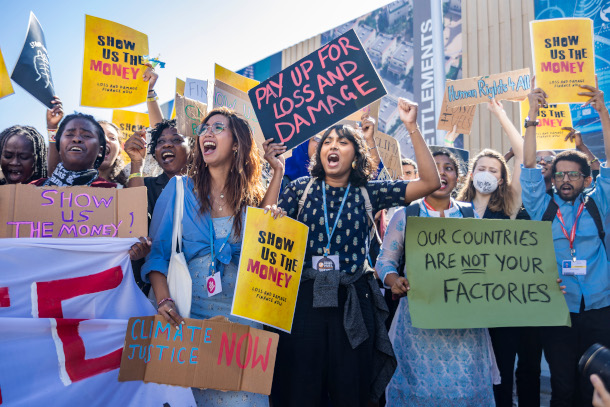
The G77, a group of mainly developing nations, are unified in advocating for a loss and damage fund to help mitigate the economic impacts of the climate crisis in developing countries. Together, the G77 represents about 80% of the world’s population. (Photo: Oliver Kornblihtt, Mídia NINJA, Flickr, CC BY-NC 2.0)
DOERING: So with these 135 countries, or 80% of the world's population, as you say, represented in terms of the countries that want to host this as an independent fund. That's a pretty significant majority. But I guess that's not how the UN works, I gather.
BERWYN: It is not how the UN works, especially the UN climate process, the UNFCCC, which is truly based on consensus and on voluntary actions and agreements. You know, there's nothing in the Paris Climate Agreement, nothing really in the United Nations Climate framework that is binding or mandatory or associated with any sort of sanctions for not doing what you said you were gonna do. And you could see that as a weakness. You could also see it as a strength that allows countries to do what they can at any given time, acknowledging that political winds shift and change. Alliances change. And it's a flexible enough process to withstand some of these things.
DOERING: Now, how much money you might this loss and damage fund eventually include?
BERWYN: It wasn't discussed in detail at this last meeting that I followed closely, but in there is one written document submitted by the developing countries block that mentions $100 billion by 2030, sort of for starters. And then there's outside independent research by climate economists and experts who are estimating loss and damage costs of up to $500 billion by 2050.
DOERING: How far back in the UN climate process does this idea of loss and damage go?
BERWYN: I think it goes back to the very beginning of the UN climate process when the Framework Convention on Climate Change was adopted or set up in 1992. And there's language in the original charter that addresses the fact that there are some countries that are feeling the impacts of greenhouse gas emissions, but don't actually emit very many greenhouse gases themselves, or none, next to none. And that there's another group of countries that have emitted a huge, huge, vast majority of the greenhouse gas emissions during the Industrial Age. And that disparity needs to be addressed by some process. You're not going to have a lasting sustainable climate solution until these things are addressed. They really kind of go hand in hand.
DOERING: And some would say that the fossil fuel companies themselves, which have been extracting this stuff, and selling it for decades now, would also be responsible. To what extent does that play into these loss and damage discussions at all?
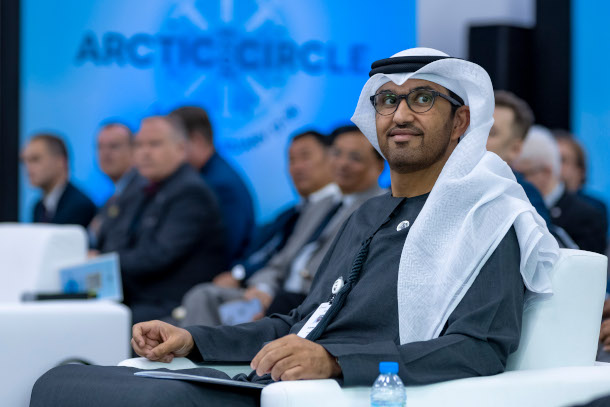
Oil company CEO Sultan al Jaber was appointed president of COP 28 by the UAE. (Photo: Arctic Circle, Flickr, CC BY 2.0)
BERWYN: It does play into it, because there were discussions about, you know, where's this money going to come from? But I think it's important that to note that, you know, in some cases, countries that influence the climate negotiations and fossil fuel companies are almost one in the same thing. I mean, if you look at Saudi Arabia, you know, and Aramco, the the state owned oil company that's also partially owned by the US, or Norway is another example, you know, where the state is involved heavily in extracting fossil fuels. So you can't always distinguish between the states and the fossil industry. And I think that's part of the problem that some individual states, basically, you know, represent fossil fuel companies interests at these talks.
DOERING: Hmm, that's a really good point. And, for that matter, I mean, the United Arab Emirates itself, which is hosting this COP in December...
BERWYN: Right.
DOERING: ...that's been a matter of great concern for some people watching this process.
BERWYN: That has been a matter of great concern. It's going to be hard for some countries to trust and believe anything regarding a commitment to reduce fossil fuel use from a company in a country that depends on that fossil fuel production for its economy.
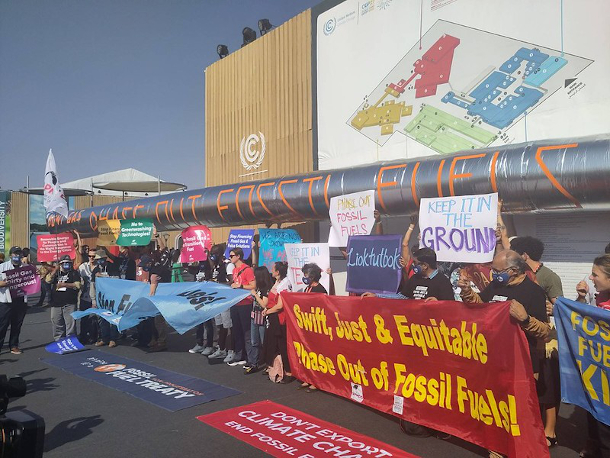
A protest by climate activists during COP27 in Sharm El-Sheikh, Egypt. (Photo: Courtesy of Ayumi Fukakusa, Friends of the Earth Japan, Flickr, CC BY-NC-ND 2.0)
DOERING: What's next on this for a loss and damage?
BERWYN: So this transitional committee that was established at COP27 are after COP27 is going to meet one more time November third to fifth. And they will try to finalize a set of recommendations for this loss and damage fund. Depending on what shape or form that takes, it will then be presented to COP28 to the plenary, the full assembly of all 196 countries there, to be debated and and voted on. Even if the loss and damage transitional committee is not able to finalize a set of recommendations in early November, I think COP28 is going to have to deal with this in one way or another. This is a test of, "Can the COP process deliver on some of its big promises that it seems to make from time to time?" You know, two years ago there was a pledge to halt global deforestation. Well, guess what? Global deforestation is still increasing. Then there was a pledge to cut methane emissions 30% by 2030. Guess what? Methane took another record jump this year. Last year, there was a promise to set up a loss and damage fund. And so I think in some ways, it's a test of if countries can follow through on what seemed to be good intentions.
DOERING: We'll have to see what happens. Bob Berwyn is a reporter with Inside Climate News based in Austria. Thank you so much, Bob.
BERWYN: Thanks for having me. And we'll check back and see how it's going.
Related links:
- Learn more about the upcoming COP28 meeting
- Read the answers to FAQs about the U.N. loss and damage fund
- Check out more of Bob Berwyn’s journalism
[MUSIC: Ida Lupino (Carla Bley), “Real Book Solo Piano” on …. By Carla Bley…(Can’t find more about the recording or the publisher)]
DOERING: Coming up, the federal government is catalyzing new hydrogen technologies with several key “hubs” across the United States.
KUSNETZ: A lot of people talk about something like 10 percent of emissions that could be addressed with hydrogen. And this is for a lot of parts of the economy that we don’t really have a good solution for. So these hubs, if they’re done right could be the biggest answer, or one of the key answers, for how to do that. (0:18)
DOERING: That’s just ahead. Stay tuned to Living on Earth.
ANNOUNCER: Support for Living on Earth comes from Sailors for the Sea and Oceana. Helping boaters race clean, sail green and protect the seas they love. More information @sailorsforthesea.org.
[CUTAWAY MUSIC: Finjan, “Dancing on Water” on A Jewish Odyssey, by Myron Schultz/Trad., arr. Finjan & Ben Mink, Putumayo World Music]
Greening Maine's Grid?
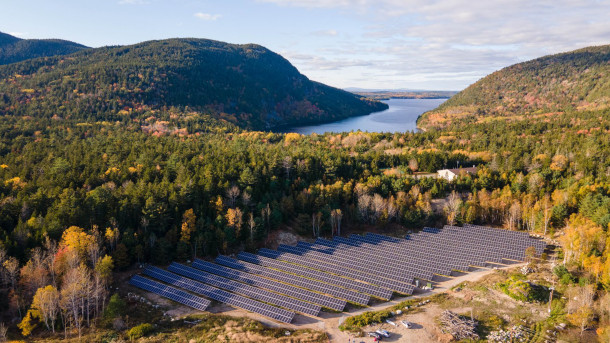
A solar array sits on top of a former landfill in Mount Desert Island, Maine, the home of Acadia National Park. (Photo: ReVision Energy)
DOERING: It’s Living on Earth, I’m Jenni Doering.
CURWOOD: And I’m Steve Curwood.
On November 7th voters in the state of Maine will be able to choose if they want to replace the state’s two existing for-profit electric utilities with the Pine Tree Power company, a non-profit customer-owned utility largely governed by an elected board. Measures like this proposal have been widely debated for years in Maine, and one was approved by the legislature in 2021, only to be vetoed by the state’s Democratic Governor, Janet Mills. This year proponents are hoping a majority of voters approve this referendum known as Question Three and create a public power company without support from the governor. Freelance reporter Annie Ropeik has been following this story and joins us now from Portland Maine. Welcome to Living on Earth, Annie!
ROPEIK: Hi, thanks.
CURWOOD: So if Maine voters approve what's called Question 3, what would switching to a statewide, nonprofit electric utility look like?
ROPEIK: So this ballot initiative would require the state to find our current investor-owned utilities unfit to serve, and it would have them sell off their systems, their poles and wires, their workforces to this new nonprofit entity. It would be run by a publicly elected board that would also appoint some subject matter experts. And then they would employ a contractor to run the system. And they would be supposed to charge what are called cost of service rates. So they don't turn any profit on top of what it costs to just provide the electricity for people; no shareholders, nothing like that. And they would have some more explicit mandates to help the state meet its climate goals and more accountability measures to report to the state on how they're doing accommodating that transition.
CURWOOD: So what's the promise for consumers' pocketbooks?
ROPEIK: The promise is mixed and uncertain and complicated. Economic analyses show long term decreases in rates. So because the new utility would not, again, be able to turn that profit, it would, on the whole, in the long term, lower rates for consumers. That's the expectation. In the short term, there is a lot of uncertainty about how much it will cost to sell the current utilities. That price is not set yet. There's expected to be a lot of debate in court, likely, about what that price should be. And that could have an effect about whether rates rise in the short term.
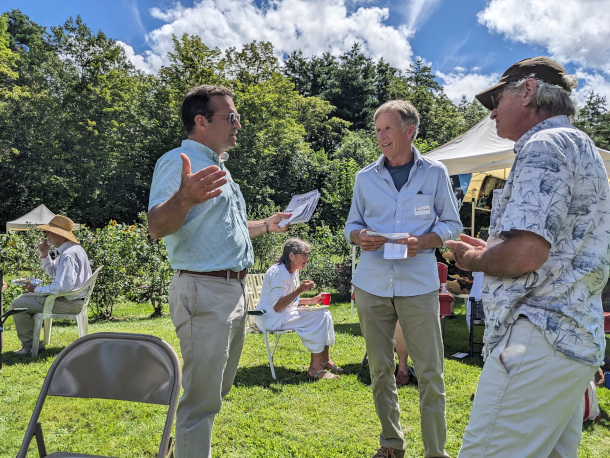
Seth Berry, left, an author of the Pine Tree Power proposal and a former Democratic state representative, answers questions from potential voters at a gathering of climate activists at a home in Winslow, Maine, on Aug. 19, 2023. (Photo: Annie Ropeik)
CURWOOD: Now who's pushing for this?
ROPEIK: The ballot initiative is backed by a number of climate and environmental groups. 350 and the Sierra Club have endorsed it. Bill McKibben has spent time up here in Maine campaigning for the initiative. Maine's environmental groups are really mixed on it, they all seem to agree that there's a lot of uncertainty, they're unhappy with the status quo, where the transition to renewable energy has been slow at times. They're not sure if this will create any less complication. But some of them say, you know, better than business as usual. Some of them say it's not worth the risk. And, you know, generally we've seen the campaign, I think, really pitching itself to younger voters on climate action, on just the dissatisfaction that people have with our current utilities on things like rates and reliability and service. And that's pretty much the pitch to voters. But it's a really mixed bag at this point as to whether it will pass, frankly.
CURWOOD: Yeah, I was gonna ask you to look at your political prognostication crystal ball and tell us what the results will be. And you're saying, who knows?
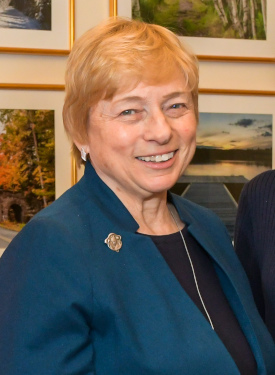
Maine Governor Janet Mills vetoed a 2021 bill that would have created a statewide nonprofit electric utility. (Photo: Rebecca Hammel, U.S. Senate, Wikimedia Commons, Public Domain)
ROPEIK: Yeah, I think it's gotten more public traction than I think I expected. You know, people are talking about it. It's gotten a ton of just advertising and media attention, maybe more so than I expected initially, when I think some of the press was like, maybe a little hesitant to touch it, because it's just, it is quite a big leap, right? It's a big solution, a big change. But especially in these past few months leading up to the election, there's just been a ton of conversation. It's gotten some national attention. And I think people are starting to hear about it more and have realized that they need to form an opinion. But the utilities, the incumbent utilities have spent millions of dollars. They're outspending supporters about 30 to one right now.
CURWOOD: Wait, wait, wait -- So the utilities that will get to keep their jobs are spending 30 to one on the public proponents' side?
ROPEIK: That's correct. Yeah, the incumbent utilities, which are Central Maine Power and Versant power, they're both owned by large, foreign-owned corporations, have spent more than $24 million to date on campaigning and advertising, direct mail, lot of digital ads. And the supporters of the Pine Tree Power plan have spent, I think about $850,000 to date, so it's about a 30 to one ratio on spending.
CURWOOD: By the way, how would this Pine Tree Power plan help Maine continue to decarbonize the electricity sector?
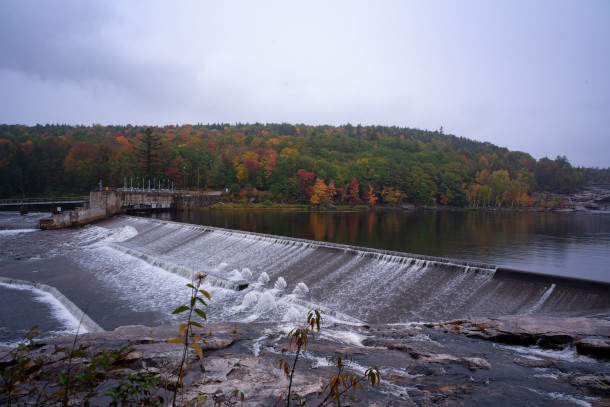
Rumford Falls Project is a hydroelectric dam on the Androscoggin River in Maine. More than a quarter of Maine’s in-state power generation comes from hydroelectric projects. (Photo: notnyt, Flickr, CC BY-NC-ND 2.0)
ROPEIK: So the new utility would have this explicit purpose to help the state meet its climate goals, and Maine has pretty aggressive climate goals. We want to be 80% renewable by 2030, a number of other goals -- Maine has pushed really hard for things like heat pumps. And so the new utility would be required to help with those efforts and to report to the state on exactly how it's doing on helping aid those efforts. Maine is deregulated, which means our electric transmission and distribution utilities can't also own power plants. So you can't own both the poles and wires and the power plants, you have to split those up. So the utilities, regardless of their ownership structure only have so much control over that fuel mix and over renewables adoption. But the experts I've been talking to say a transmission utility does have a huge role to play in modernizing the grid and creating a grid that can accommodate all those new renewables and respond to climate change. So they have a huge role play, a huge amount of investment they need to make in enabling this transition quickly and equitably.
CURWOOD: Okay, Annie, before you go, I want you to put on your sociologist's hat. What does this election over having a single publicly owned power company, what does it say about how people feel in Maine about electricity, about the climate crisis, about the role of government in general?
ROPEIK: It's a great question. I've thought a lot about this. I really see this election as a statement on who people want as a leader, as we undertake this incredibly complex and important transition. Do they want government leadership, public leadership, sort of democratized leadership? Or do they trust businesses and, you know, whatever version of the free market exists in the energy system, and the power of the investment incentive? Do they trust that to lead the charge? It also just says a lot about how broken trust between utilities and regulators in the public can lead to big swings like this at the ballot box. You know, I think a lot of the experts I've talked to have said, if you had a state where people were happier with their utilities, where there hadn't been a lot of problems with the reliability, where the rates weren't really high, you know, people weren't just sort of overall mistrustful of the incumbent companies, that you wouldn't see it come to something like this. So the ownership structure doesn't inherently address the climate crisis, but it could create more of that public trust and regulatory accountability to ease the transition, especially given just the frustration and kind of log jams we're facing in our current system.
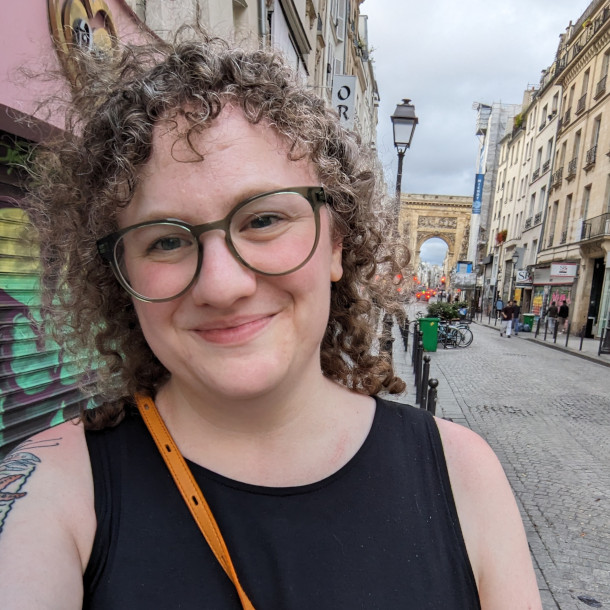
Annie Ropeik is an award-winning independent climate journalist based in southern Maine. She writes for The Maine Monitor, Inside Climate News and others. (Photo: Annie Ropeik)
CURWOOD: Well, thanks for taking the time with us today. Annie Ropeik is a freelance reporter who's written about this for the Maine Monitor and our media partner, Inside Climate News. Thanks again for taking the time.
ROPEIK: Thank you so much, Steve.
CURWOOD: And tune in next week to hear about another way to decarbonize the power grid through what are called “virtual power plants” that rely on smart thermostats, EV batteries and more.
Related links:
- Inside Climate News | “Mainers See Climate Promise in Ballot Initiative to Create a Statewide Nonprofit Electric Utility”
- The Maine Monitor | “Debating Maine’s Energy Future in Question 3”
[MUSIC: Danny Black, “High Tide” on Adventure Soundtrack, Nettwerk Music Group Inc.]
Advancing Hydrogen with Government Funded Hubs

The Biden administration says the new hydrogen hubs will help cut national greenhouse gas emissions. (Photo: Prachatai, Flickr, CC BY-NC-ND 2.0)
DOERING: Hydrogen is getting a lot of attention as a key potential fuel source to replace fossil fuels in the future clean energy economy, because when it’s burned the end product is simply water. With help from funding from the Bipartisan Infrastructure Law, that future may soon be a reality. After a competitive application process, President Biden recently announced the recipients of up to $7 billion in grants for seven hydrogen hubs across the country. Each “hub” will include a network of producers, consumers, and transporters of hydrogen, creating a model for what this new energy market might look like. But replacing fossil fuels with hydrogen isn’t necessarily guaranteed to bring climate benefits. Here to explain is Nicholas Kusnetz, who covered this for our media partner Inside Climate News. Welcome back to Living on Earth, Nick!
KUSNETZ: Hi, thank you for having me on the show.
DOERING: What are the Biden administration's goals in creating these hydrogen hubs? Why are they investing this money?
KUSNETZ: So the hope is that hydrogen could play an important role in helping to cut the nation's climate emissions and climate pollution. And in particular, the hope is that hydrogen could play a role in a number of sectors for which there aren't really good options right now. And in fact, the legislation that created these hubs spelled out some of them. A big one is heavy industry. So things like steel making, you could use hydrogen where the steel plants are currently using natural gas. Hydrogen could also be used for long haul trucks. And in that case, they might be used almost like a battery, in something called a fuel cell. Hydrogen could be used to power ships. It could even be used to make like a synthetic jet fuel. So those are, I think, what a lot of people see as some of the most promising or important potential places. But there's few if any examples of this happening today. And there's certainly nothing close to the scale that would be needed. So the hubs are meant to start to kind of build a model and test out what works and what doesn't.
DOERING: So Nick, as you report, not all hydrogen is created equal. Why is that? And what do we know about where these hubs fall on that spectrum?

Hydrogen could potentially be used in a variety of hard-to-decarbonize industries, from long haul trucking to steel making. (Photo: Karl Neuman, Flickr, CC BY 2.0)
KUSNETZ: Sure. There are different ways to make hydrogen. And there is already hydrogen production. Hydrogen is used in oil refining, it's used to make fertilizers. So there's some existing production. And that's almost all made from natural gas, in a process that releases a lot of carbon dioxide, so a lot of climate pollution. It's a dirty process. and the hope is that that can be cleaned up. And one way is to do essentially the same process, but to capture the carbon dioxide emissions, you know, to use technology to pull that out of the smokestacks. And that gas could then be compressed and pumped underground. That's become known as blue hydrogen. And that is getting a lot of investment and interest from oil and gas companies in particular, because it uses natural gas, so it'd be a new market for their products. But hydrogen can also be made with electricity. And if that electricity is generated by wind or solar power, for example, you know, an emissions free source, then you can theoretically make zero emissions or extremely low emissions hydrogen, by just putting electricity to take the hydrogen out of water. And the hubs are investing in all of this. And there was legislation that said the hubs had to invest in a number of different sources, but some of them are doing a combination. At least three of them are going to be making hydrogen with natural gas, carbon capture. And so there are more that are using so called green hydrogen, you know, with renewable energy. The Biden administration said it was two thirds, in some cases, there's hubs that are doing both.
DOERING: To what extent does blue hydrogen rely on carbon capture technology that actually works?
KUSNETZ: The only way that you would be able to claim to make clean hydrogen from natural gas is if you captured pretty much all of the carbon dioxide that's released in that process. There are no existing examples of this. There are a couple of hydrogen projects that do have carbon capture operations. They weren't really designed to capture 90 plus percent of this carbon dioxide that comes out of them, which is what you'd need. And so I think you have critics looking at it and saying, like, look, we don't know if we can do this. It's never been done. And various attempts to run kind of commercial scale projects that have those kinds of high capture rates have failed. The sort of supporters say, well, we haven't really tried, basically.
DOERING: So in terms of blue hydrogen, it's not the cleanest kind of hydrogen. So why even include it in these hubs?
KUSNETZ: Well, there are, I think, a couple of different answers for that. There's the political answer, which is, of course, it's a huge constituency, or it's a very powerful constituency, the fossil fuel industry. The fossil fuel industry lobbied very hard to make sure that it wouldn't get cut out from hydrogen funding. Joe Manchin, the West Virginia Senator, and many other members of Congress and people in the White House acted to make sure that natural gas was included. I think there are also people who say that we're going to need to scale this up pretty significantly, and that there are questions about whether we can really make that much hydrogen from just renewable power, whether there's enough wind and solar or will be enough wind and solar power available. And so the hope from those people is that companies can really figure out how to do it cleanly with natural gas as well, and that you'll find of need every tool, you know, that's disposable.
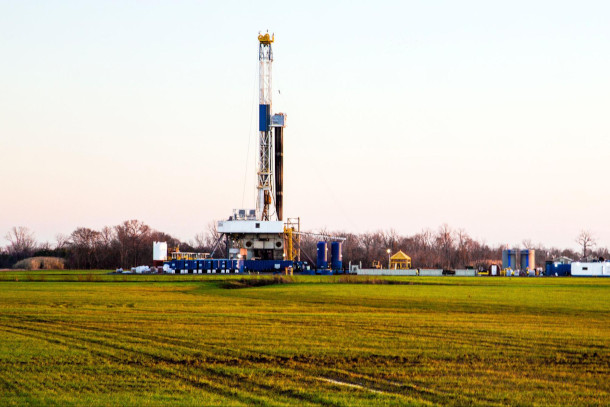
“Blue” hydrogen, which is made using natural gas and carbon capture technology, could repurpose existing fossil fuel infrastructure. (Photo: Daniel Foster, Flickr, CC BY-NC 2.0)
DOERING: So how much of a role is the oil and gas industry playing in these hydrogen hubs?
KUSNETZ: The oil and gas industry has a big role in a number of the hubs. There's the Gulf Coast hub, for example, which is going to be centered around Houston and, you know, that part of the Gulf Coast. And ExxonMobil is a big player in that one. Chevron is involved. Houston is, of course, the capital of the nation's oil and gas industry. The Appalachian hub as well has some fossil fuel interests. EQT, which is the nation's biggest gas producer is a partner are one of the companies involved in that hub. And there's some oil and gas companies involved in some of the other hubs as well like one in the northern Great Plains.
DOERING: And looking more broadly, how has the oil and gas industry shaped hydrogen policy.
KUSNETZ: So the oil industry, I think, has played a really big role in the legislation that's come out of Congress and the policy out of the White House over the last few years. And the two big ones are the Bipartisan Infrastructure Bill and the inflation Reduction Act. And so the the Infrastructure Bill created these hydrogen hubs, and then the Inflation Reduction Act created a new tax incentive for clean hydrogen that is dependent on how much is produced but could potentially be tens, hundreds of billions of dollars, over a decade. I think you could think of the hubs as looking to try to build the model for a clean hydrogen economy. But if they're the model, then the inflation Reduction Act is actually trying to get that economy built, right, and trying to provide the money to private industry to really bring it to scale. And so the oil and gas industry has been lobbying really hard to make sure that blue hydrogen, you know, that hydrogen made with natural gas and carbon capture can qualify for both of these, for the hub funding and for the credits, and they're continuing to do so, I mean, right now, the Treasury Department is working on the rules that will determine what is clean exactly, right, and how to qualify your hydrogen as clean. And so the industry is lobbying the White House, it's lobbying the Treasury Department, on the kind of intricacies of that and how that will be determined.
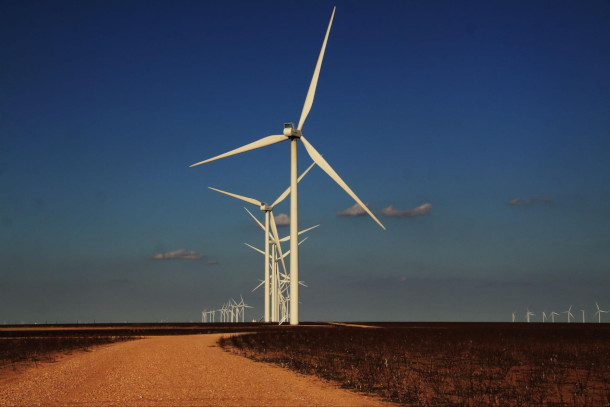
“Green” hydrogen is made using electricity derived from renewable energy sources. (Photo: Charles Blount, Flickr, CC BY 2.0)
DOERING: So some of these hubs are located in regions where fossil fuel based jobs have been dominant. To what extent can some of those workers tap into new jobs created by these hydrogen hubs?
KUSNETZ: That's certainly the goal and the plan. And that was why the legislation directed that at least some of the hubs be in fossil fuel dependent regions. Like the Appalachian one is a good example. You saw the winner of that hub promising to make, you know, thousands and thousands of new jobs, right? And the argument is that these are going to be in some sort of heavy industries that are a good match for some of the jobs that might otherwise be lost. And the Biden administration has very much made jobs and employment a big piece of its climate agenda. And this promise that transitioning the nation off of fossil fuels and cutting emissions does not have to just mean the loss of jobs, but the creation of new jobs.
DOERING: And to what extent is there an environmental justice requirement here?
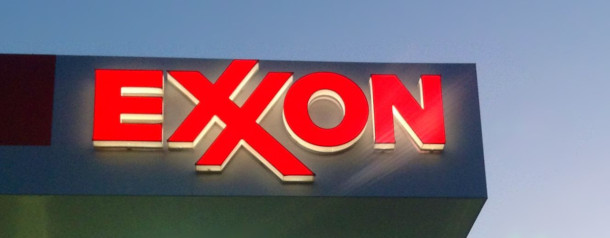
Several fossil fuel giants like ExxonMobil and Chevron will play key roles in the new hydrogen hubs. (Photo: Mike Mozart, Flickr, CC BY 2.0)
KUSNETZ: The question of how these will fit into the administration's environmental justice goals, I think is a big open one. One of the big critiques so far of this hydrogen hub process has been that the department has not been transparent with, with what's happening. Because of that there's a real concern, I think that these projects will move forward without the kind of level of community engagement that would ensure that they don't increase pollution for certain communities, because there are ways in which producing hydrogen could increase certain local air pollutants, right? Like if you're burning more natural gas, even if you capture the carbon dioxide, there can be some other criteria air pollutants that things like that go into smog, for example, right, and affect the air quality of communities. So those wouldn't sort of necessarily be improved for communities, right, and could even get worse. I mean, the administration has sort of committed to trying to prevent that from happening and trying to include local communities. But I think, well, certainly local communities don't feel like they're living up to that yet.
DOERING: Well, let's say these hubs do manage to meet the goals that the Biden administration has set. What could their potential impact be?
KUSNETZ: The impact of the hubs, if they're successful, could be significant. I mean, a lot of people talk about something like 10% of the nation's emissions, global emissions, really, that could be addressed with hydrogen. And this is for a lot of parts of the economy that we don't really have a good solution for. Developments over the last decade amid wind and solar power generation really cheap and really effective. And so it's sort of within our grasp to clean up the electricity grid. But that's only, you know, roughly a third of the nation's emissions, right? There are a lot of sectors, like heavy industry, like aviation, like steel and iron, for example, are really significant source of the planet's emissions, and there really aren't good solutions for how to clean that up right now. So these hubs, you know, if they're done right, could be either the biggest answer or one of the key answers to how to do that.
DOERING: Nicholas Kusnets is a reporter for our media partner Inside Climate News. Thank you so much, Nick.
KUSNETZ: Thank you for having me on the show.
Related links:
- The Biden Administration’s announcement
- Learn more about the hydrogen “color spectrum”
- Living on Earth on the future of hydrogen
- Inside Climate News | "Biden Announces Huge Hydrogen Investment. How Much Will It Help The Climate?"
[BIRDNOTE THEME]
BirdNote®: Spooky Shearwaters
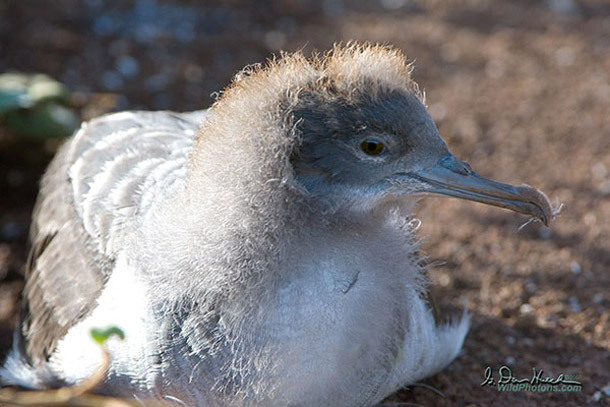
The Wedge-tailed Shearwater’s unusual moaning call once terrified sailors from Europe. (Photo: Dan Hutcheson)
CURWOOD: At Halloween, we think of ghoulies and ghosties and long-leggitty beasties – indeed, you may even get some of them at your door demanding candy. And as Michael Stein tells us in today’s BirdNote®, some of our avian acquaintances would fit right in.
BirdNote®
The Spooky Shearwaters
Imagine yourself an 18th Century sailor, rowing out from your boat at night toward a remote Pacific island. You’re heading to the island to find fresh water for the ship, only to be greeted by this frightful moaning.
[Wedge-tailed Shearwaters wailing]
Some early sailors feared this ungodly wailing meant they had been tricked ashore at the gates of Hell itself, when in truth they stood shuddering among courting pairs of seabirds called Wedge-tailed Shearwaters.
[Wedge-tailed Shearwaters wailing]
Dark, gull-sized seabirds with long, thin, tapering wings, Wedge-tailed Shearwaters nest on islands in the tropical Pacific and Indian Oceans, from Hawaii to western Australia to Madagascar. Most dig burrows to nest in, two to six feet deep with a bend that allows the incubating birds to rest unseen. From dusk to midnight during courtship, pairs of Wedge-tailed Shearwaters sit facing one another on the ground, and puff up their throats to perform long duets of eerie wailing – sometimes sending spooked sailors rowing in panic back to their ship for a ration of grog.
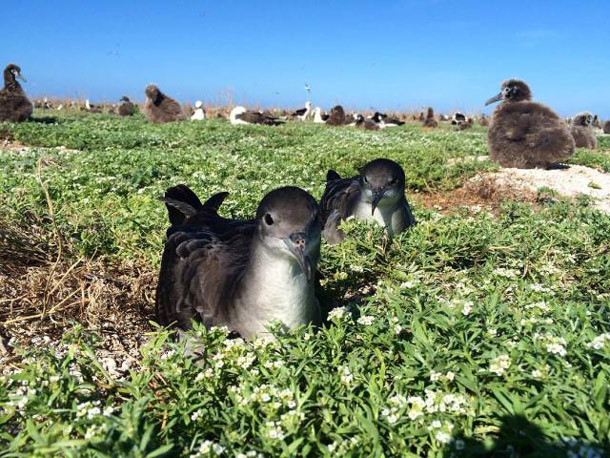
Wedge-tailed Shearwaters nest on the ground. Their range stretches from Hawaii and the Pacific all the way to the beaches of Madagascar. (Photo: US Fish and Wildlife Service)
[Wedge-tailed Shearwaters wailing]
I’m Michael Stein.
###
Written by Bob Sundstrom
Call of the Wedge-tailed Shearwaters provided by The Macaulay Library of Natural Sounds at the Cornell Lab of Ornithology, Ithaca, New York. Wedge-tailed Shearwater 1801 recorded by F.N. Robinson
Ambient ocean sound recorded by John Kessler
BirdNote's theme music was composed and played by Nancy Rumbel and John Kessler
Producer: John Kessler
Executive Producer: Dominic Black
© 2005-2017 Tune In to Nature.org October 2017 Narrator: Michael Stein
CURWOOD: For pictures, sail on over to the Living on Earth website, loe dot org.
Related link:
The “Spooky Shearwaters” story on the BirdNote® website
[MUSIC: Carolina Eyck, “The Flight of the Bumblebee” on Amazing Theramin Music Compilation, by Nicholas Rimsky-Korsakov, Published on YouTube by Zlatno Doba]
DOERING: If you enjoy the stories you hear on Living on Earth, please consider signing up for our newsletter. You’ll never miss a show, and you’ll have special access to show highlights, notes from our staff, and advanced information about upcoming live events. The Living on Earth newsletter is sent to your inbox weekly. Don’t miss out! Subscribe at the Living on Earth website, loe.org.
DOERING: Just ahead, the “sacred groves” in China that have been protected for thousands of years as the homes of ancestral spirits. Keep listening to Living on Earth
ANNOUNCER: Support for Living on Earth comes from Friends of Smeagull the Seagull and Smeagull’s Guide to Wildlife. It’s all about the wildlife right next door to you! That’s Smeagull, S - M - E - A - G - U - L - L, SmeagullGuide.org.
[CUTAWAY MUSIC: Miles Davis, “Freddie Freeloader” on Kind Of Blue, Sony Music Entertainment]
Beyond the Headlines
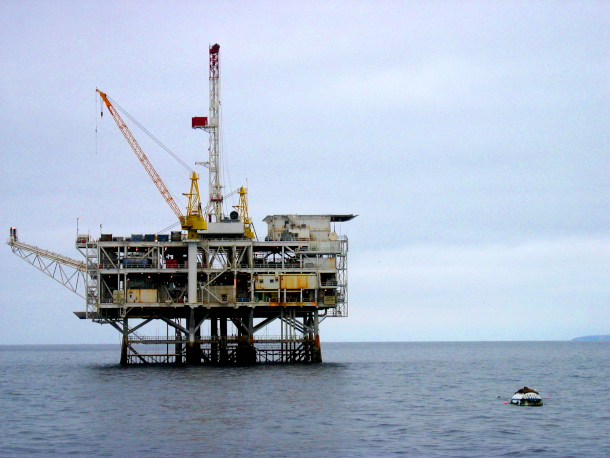
Activists are debating the fate of old oil rigs, as they have become artificial reefs teeming with life below the surface of the ocean. (Photo: Marianne Muegenburg Cothern, Flickr, CC BY-SA 2.0)
DOERING: It’s Living on Earth, I’m Jenni Doering.
CURWOOD: I'm Steve Curwood. Joining me now on the line from Atlanta, Georgia is Peter Dykstra Living on Earth contributor who takes a look beyond the headlines for us. Hi, there, Peter. How you doing?
DYKSTRA: Hi, Steve, we're going to start out with a story that's offshore in areas like the Gulf of Mexico and the California coastline that have aging and retired oil rigs. And there's a debate underway whether those oil rigs should be removed, because they're an eyesore, or kept as a marine benefit, because they draw so much marine life around them.
CURWOOD: Peter, you have to admit they are ugly, but you're talking about how great they are for fish, apparently.
DYKSTRA: They're great for marine life from the bottom to the top of the food chain. Everything from micro organisms to small fish, to bigger fish and mollusks, like mussels, also barnacles, all the way up to the big fish and the sea lions that eat them, they can use that oil rig structure as sort of an anchor to build a real paradise and a draw from marine life, which in turn can be a draw for fishermen.
CURWOOD: So maybe there's some value in having these retired oil rigs as artificial reefs.
DYKSTRA: Some folks would rather just see them go, the oil industry gets off the hook by not having to remove the rigs. And also they are able to take credit for an environmental benefit, something that oil companies can rarely do.
CURWOOD: Indeed, Hey, Peter, let's have your gaze look in another corner. What's going on beyond the headlines? What do you see?
DYKSTRA: Well, Creation Care is the name of theory or practice, where churches claim some of the responsibility for addressing climate change and other environmental issues. And one of the things that's happening is that churches with all that roof space in most church designs are embracing solar panels. And some of those churches are able to cover all of their electric bills, or most of them by generating their own solar power.
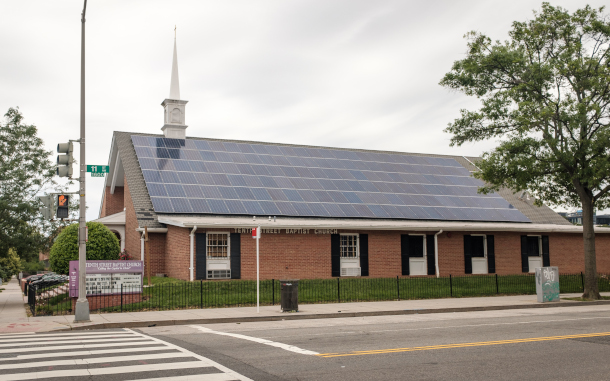
Some churches are investing in solar panels to cut costs and reduce their environmental footprints. (Photo: ep_jhu, Flickr, CC-BY-NC 2.0)
CURWOOD: So how far is this movement advanced? I mean, solar cells have been around for a long time. But what's different now maybe that they're cheaper?
DYKSTRA: There's so much cheaper, they're getting even more cheap. There are state incentives in some states. There are also organizations like Interfaith Power and Light, that have been promoting the ways that churches can help contribute positively to the climate crisis.
CURWOOD: So churches can play to the light within or the light from above
DYKSTRA: The light within the light from above, and they can keep the lights on.
CURWOOD: Hey, you've got all those history volumes around you. What do you have from the history books today for us?
DYKSTRA: Let's blow the dust off one, and go back to October 27, 1904. New York City's first subway line opens up nine miles long from City Hall in Manhattan, up to 140/5 Street in Harlem.
CURWOOD: Wow, that's quite a distance. That first subway line really expanded in New York ultimately, right?
DYKSTRA: It did counting elevated lines and subway tracks. All over the five boroughs. There's even a Staten Island IRT; New York is largely subway dependent. There's been a love-hate relationship between New Yorkers and the subway. They had a crisis when New York had a financial crisis in the 1970s. But they bounced back and are in better shape than their darker days. New York is a leader in this country, with all those tracks and with millions upon millions of riders every year.

New York City established its first subway line on October 27, 1904. (Photo: Henrik Johansson, Flickr, CC BY-NC-ND 2.0)
CURWOOD: By the way, Peter, since that first line, how have they improved the wait times for those subways in New York?
DYKSTRA: I gotta go Steve. My train is here.
CURWOOD: Peter Dykstra is a contributor to Living on Earth and we'll talk to you again real soon.
DYKSTRA: All right, Steve, thanks a lot. Talk to you soon.
CURWOOD: And there's more on these stories at the living on Earth website. That's loe.org.
Related links:
- The Guardian | “‘Every Square Inch Is Covered in Life’: The Ageing Oil Rigs That Became Marine Oases”
- State Impact Pennsylvania | “How Pennsylvania Churches Are Addressing Climate Change by Tapping the Power of the Sun”
- The First Subway | “Atlas of Disaster”
[MUSIC: Chris Standring, “Love and Paragraphs” on Love and Paragraphs, Ultimate Vibe Recordings.]
Sacred Groves in China
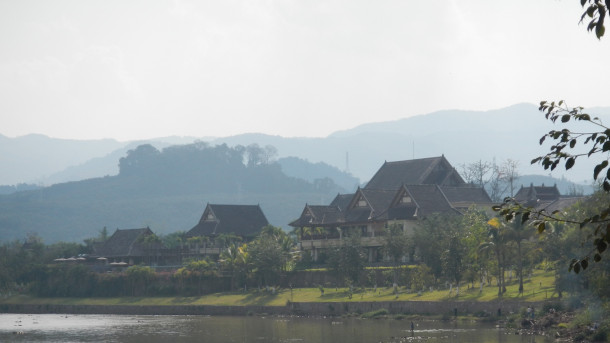
This Holy Hill in the Dai village of Chengzi, surrounded by monoculture rubber plantations, contains tall old-growth trees. (Photo: Lily Zeng)
DOERING: “Creation care” is just another name for the environmental stewardship that the faithful have been doing for thousands of years in many different traditions around the world. In the Yunnan Province in Southwest China, locals have protected sacred forest groves that some consider the homes of the spirits of their ancestors. Lily Zeng researched these “holy hills” as part of her doctoral studies at Yale School of the Environment and she joined Living on Earth’s Bobby Bascomb to describe them.
BASCOMB: So for someone who's never been to this part of China, can you describe for us, please, the holy hills? What's so special about the area?
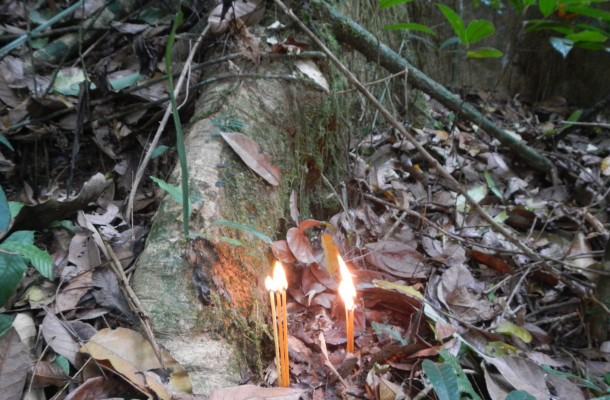
Before Dr. Zeng and her team conducted biological surveys in this Holy Hill in the village of Chengzi, the village shaman burned traditional incense and asked for the Holy Hill spirit’s blessing. (Photo: Lily Zeng)
ZENG: So I work in a region of China called Xishuangbanna, which is in the southwest corner, right on the border of Laos and Myanmar. It's a really special area in terms of the biodiversity there. Even though this prefecture is only 0.2%, of China's land area, it has 16% of China's biodiversity in terms of its plants. It also has 22% of China's mammals, 15% of China's reptiles and amphibians, and many of these species are found nowhere else in China. It's also really special because of the high cultural diversity. So China officially has 56 ethnic groups. So it's 55 minorities plus the dominant Han, and 75% of the people here are ethnic minorities. So you can see it's just such a special part of China. And then the holy hills are really an important part of this region, because this region has been going through a lot of change. These forests have been converted to monoculture rubber plantations. In the face of all this very rapid conversion, some of the only remnants of tropical rainforest that you find outside of the state protected nature reserves are these patches of forest that are protected by ethnic minorities slash indigenous groups for religious and cultural reasons.
BASCOMB: And I understand that you traveled there. What does it feel like for you to be there?
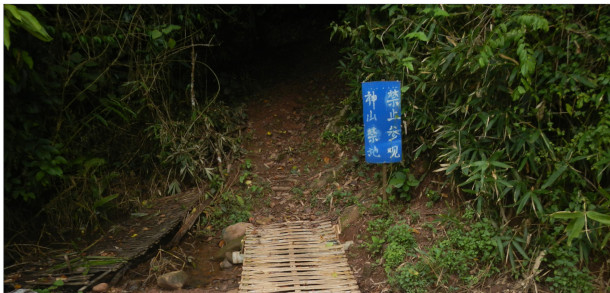
The sacred forest in the village of Manlang was cut down during the Cultural Revolution of the 1970s. When policies changed in the 1980s, the village consecrated a patch of land and let trees start to grow back. (Photo: Lily Zeng)
ZENG: Yeah, holy hills are amazing spaces. And they're also really different. Some of the ones I've been in are fairly curated. So you have a beautiful statue in the middle. And then they have these old tall trees. And it almost feels like being in a church except made of trees. And then you have other ones that are more, I guess, forests in the way that we think of them, except this is in a tropical ecosystem. So they're basically jungles. And there are lianas, and lots of plants that have formed and it's very ouch. [LAUGH]
BASCOMB: And the name holy hill, I'm assuming that they're actually hills, or small mountains that we're talking about.
ZENG: I would say that they're more isolated fragments of forest. The name of holy hill was coined by a famous, the father of Chinese ethnobotany, who's named Pei Shengji, and he's a wonderful man, who I respect tremendously. This was his English name for them. But really, their defining feature I would think, is that the communities have consecrated this patch of land to be the home to their ancestral spirits.
BASCOMB: So tell me more about the local people that live around the Holy Hills and their relationship with the land.
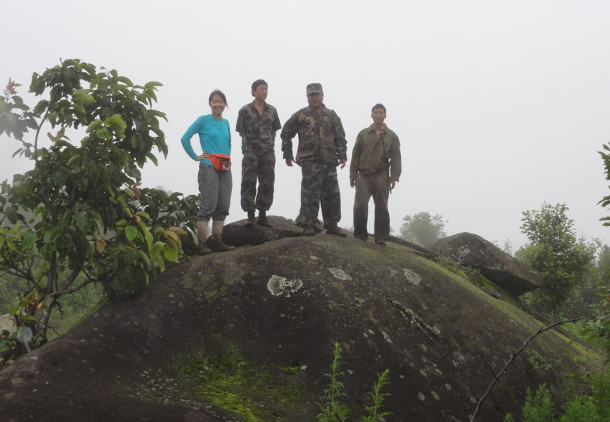
Women are traditionally forbidden from entering Holy Hills, but with special permission, Dr. Zeng was allowed to conduct biological surveys in the area. (Photo: Courtesy of Lily Zeng)
ZENG: So these Holy Hills are sacred spaces, where entry is often forbidden. For instance, one of the most common taboos is that women are not allowed to enter this sacred space. So obviously, as a female researcher working on this, that presented a number of challenges. So I know for a fact that there are a number of rituals associated with it. For instance, it often involves an animal sacrifice, depending on the village. It could mean, chickens, it could mean a pig. And then the bomo, so the shaman, will bring the animal sacrifice in and then the men of the village will go participate. And there are a number of rituals to ask the spirit in terms of how's the village doing, in terms of various aspects of well being, I can't actually tell you about what that looks like, because I wasn't allowed to join. But I saw a few pictures. There's often this idea that because holy are an old cultural tradition, that it has to reference old things. But this actually is a part of everyday life, in contemporary life. So for instance, many Dai communities I work with right now, their main source of income is rubber. And so even as I was speaking early on, I know that there's this idea of the tendency to have the dichotomy between protecting the forests versus economic development for rubber. But in fact, this community I was working with, they were praying to their Holy Hill spirit to protect their rubber plantations.
BASCOMB: If there's been so much development around these Holy Hills, to what degree is a sacred grove, are these Holy Hills completely untouched by people, you know, pristine, old growth forest? Or is the concept of sacred or holy more nuanced than that? Can it change?

Dr. Zeng interviews Dai women while they prepare food. (Photo: Courtesy of Lily Zeng)
ZENG: I think one of the really cool things about sacred forests in general, not only Holy Hills, is that they're really seen as a way to not only protect biodiversity, because these often tend to be located in ecosystems that are underrepresented in protected areas, but also to marry conservation goals with social benefits for local communities. Many people see sacred forests as an alternative to fortress conservation approaches, which is something that speaks to the idea of pristine nature that you mentioned in terms of preserving nature through the forceful exclusion of people, which often has unfortunate consequences for the communities and people surrounding a piece of nature that is being protected. One of the things that my research was showing was how some of these forests were, if you just do your ecological survey, you might say, wow, this is a fragmented forest that looks like it's been degraded. And it shows how these fragmented forests really aren't able to maintain levels of biodiversity comparable with nature reserves, yada yada yada. Whereas one of the forests that I was with in the village of Manlang, it was really cool because I was learning from my time there, that this particular Holy Hill had been cut down and planted with commercial firewood trees during the Cultural Revolution in the 1970s. And then, when the policies changed in the 80s, Manlang recreated this sacred forest by consecrating a patch of land and letting the forests grow back, and then what I thought was so amazing, with all the emphasis on conservation, on preserving forest, it was so remarkable that after a forest was destroyed, it could be resurrected through a community's connection with the sacred. And so when I asked for permission to enter this particular Holy Hill to conduct the botanical surveys, the community leadership initially was very reluctant, mainly because women are traditionally forbidden to enter Holy Hills. But ultimately, this particular village allowed my botanical surveys in return for me providing some tree seedlings with support from Xishuangbanna Tropical Botanical Garden in order to help restore their Holy Hill. And it was really, really a huge honor and so special for me, because then I became the first and only female who had ever set foot in this particular Holy Hill.
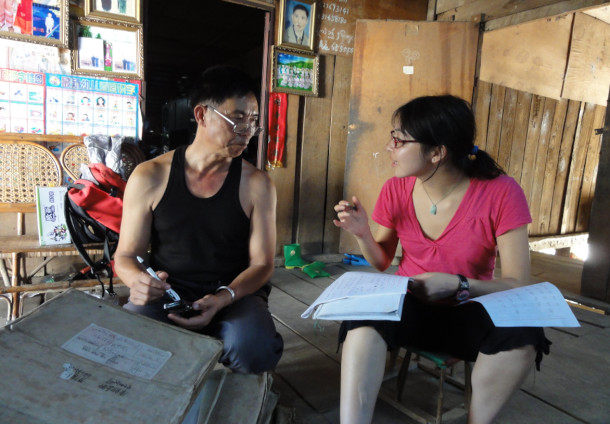
Dr. Zeng conducts an interview with a village elder. (Photo: Courtesy of Lily Zeng)
BASCOMB: And so what was it like once you were there?
ZENG: Because this was a forest that had previously been planted with other things and then cut down, it wasn't the same kind of forest you think of with like, wow, this tree is 500 years old, and you could drive a car through it. It was special because of what I knew the forest had represented and the layers of meaning that I knew were embedded in the trees I saw around me.
DOERING: That’s Yale scholar Lily Zeng speaking with Living on Earth’s Bobby Bascomb.
Related link:
About Lily Zeng’s Research
[MUSIC: Weishan Liu, “Polly’s Journey” on Morning Bell, Weishan Liu]
CURWOOD: Next week on the show, don’t forget to tune in to hear about “virtual power plants”. A study by a consulting group shows how Virtual Power plants that combine financial incentives with software and smart hardware can reduce reliance on high polluting power plants and pressure on the power grid during peak energy use hours.
HLEDIK: So, a virtual power plant is basically a collection of customers – it could be residential households, it could be commercial buildings – who have been recruited into a program and being provided incentives to participate in order to provide some of these services to the grid. It’s basically this idea where customers have a lot of flexibility in their demand for electricity. Customers who are buying electric vehicles have the ability to change when they are charging that car, to a degree. Customers with smart thermostats can manage the thermostat in a way that changes when they are cooling their home. One state that you might not immediately think of that has a really interesting program is Vermont and the utility Green Mountain Power in Vermont, where the utility is providing customers with subsidized batteries that the customers get to install in their homes. The customers benefit from having that battery available as a form of backup power. But in return for receiving that heavily discounted battery from the utility, the utility gets to manage that battery during certain days of the year to provide benefits to the power grid. And it's a really interesting kind of win win situation because the customer gets that resilience benefit. The utility is able to reduce costs on the power grid and keep the power grid reliable. And then on top of that Green Mountain Power is focusing on deploying these batteries in locations of their grid that have lower than average reliability, and where there are customers with lower-than-average incomes. So, it's a great way to provide a lot of benefits and a lot of different ways through a single virtual power plant program.
CURWOOD: How electric cars, smart thermostats and other tech can plug into these virtual power plants, next time on Living on Earth.
[MUSIC: Weishan Liu, “Polly’s Journey” on Morning Bell, Weishan Liu]
CURWOOD: Living on Earth is produced by the World Media Foundation. Our crew includes Naomi Arenberg, Paloma Beltran, Josh Croom, Swayam Gagneja, Mattie Hibbs, Mazzi Ingram, Mark Kausch, Mark Seth Lender, Don Lyman, Sarah Mahaney, Aynsley O’Neill, Sophia Pandelidis, Jake Rego, El Wilson, and Jolanda Omari.
DOERING: Tom Tiger engineered our show. Alison Lirish Dean composed our themes. You can hear us anytime at L-O-E dot org, Apple Podcasts and Google Podcasts, and like us, please, on our Facebook page - Living on Earth. We tweet from @livingonearth. And find us on Instagram at livingonearthradio. And you can write to us at comments at loe dot org. I’m Jenni Doering.
CURWOOD: And I’m Steve Curwood. Thanks for listening!
ANNOUNCER: Funding for Living on Earth comes from you, our listeners, and from the University of Massachusetts, Boston, in association with its School for the Environment, developing the next generation of environmental leaders. And from the Grantham Foundation for the protection of the environment, supporting strategic communications and collaboration in solving the world’s most pressing environmental problems.
ANNOUNCER 2: PRX.
Living on Earth wants to hear from you!
Living on Earth
62 Calef Highway, Suite 212
Lee, NH 03861
Telephone: 617-287-4121
E-mail: comments@loe.org
Newsletter [Click here]
Donate to Living on Earth!
Living on Earth is an independent media program and relies entirely on contributions from listeners and institutions supporting public service. Please donate now to preserve an independent environmental voice.
NewsletterLiving on Earth offers a weekly delivery of the show's rundown to your mailbox. Sign up for our newsletter today!
 Sailors For The Sea: Be the change you want to sea.
Sailors For The Sea: Be the change you want to sea.
 The Grantham Foundation for the Protection of the Environment: Committed to protecting and improving the health of the global environment.
The Grantham Foundation for the Protection of the Environment: Committed to protecting and improving the health of the global environment.
 Contribute to Living on Earth and receive, as our gift to you, an archival print of one of Mark Seth Lender's extraordinary wildlife photographs. Follow the link to see Mark's current collection of photographs.
Contribute to Living on Earth and receive, as our gift to you, an archival print of one of Mark Seth Lender's extraordinary wildlife photographs. Follow the link to see Mark's current collection of photographs.
 Buy a signed copy of Mark Seth Lender's book Smeagull the Seagull & support Living on Earth
Buy a signed copy of Mark Seth Lender's book Smeagull the Seagull & support Living on Earth

